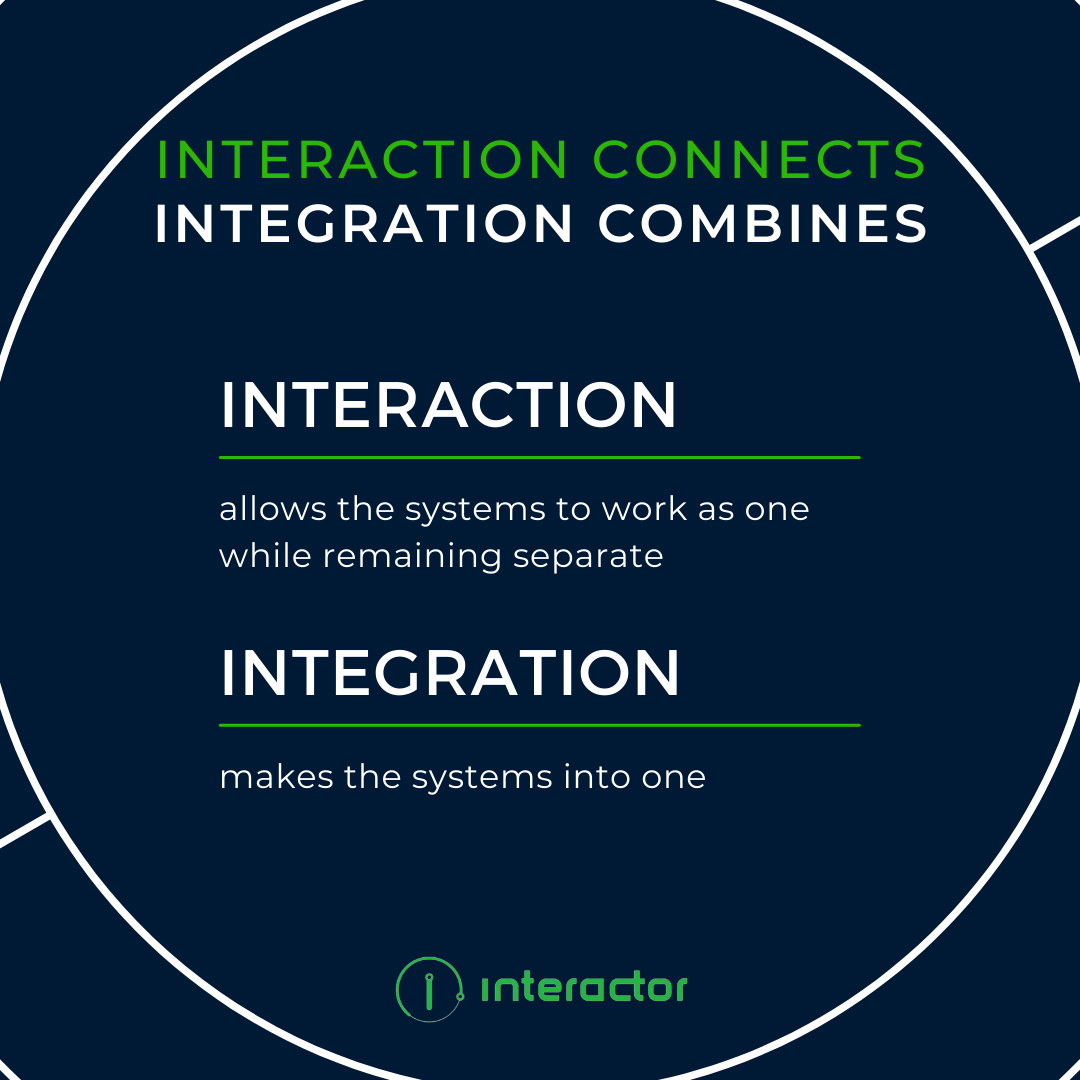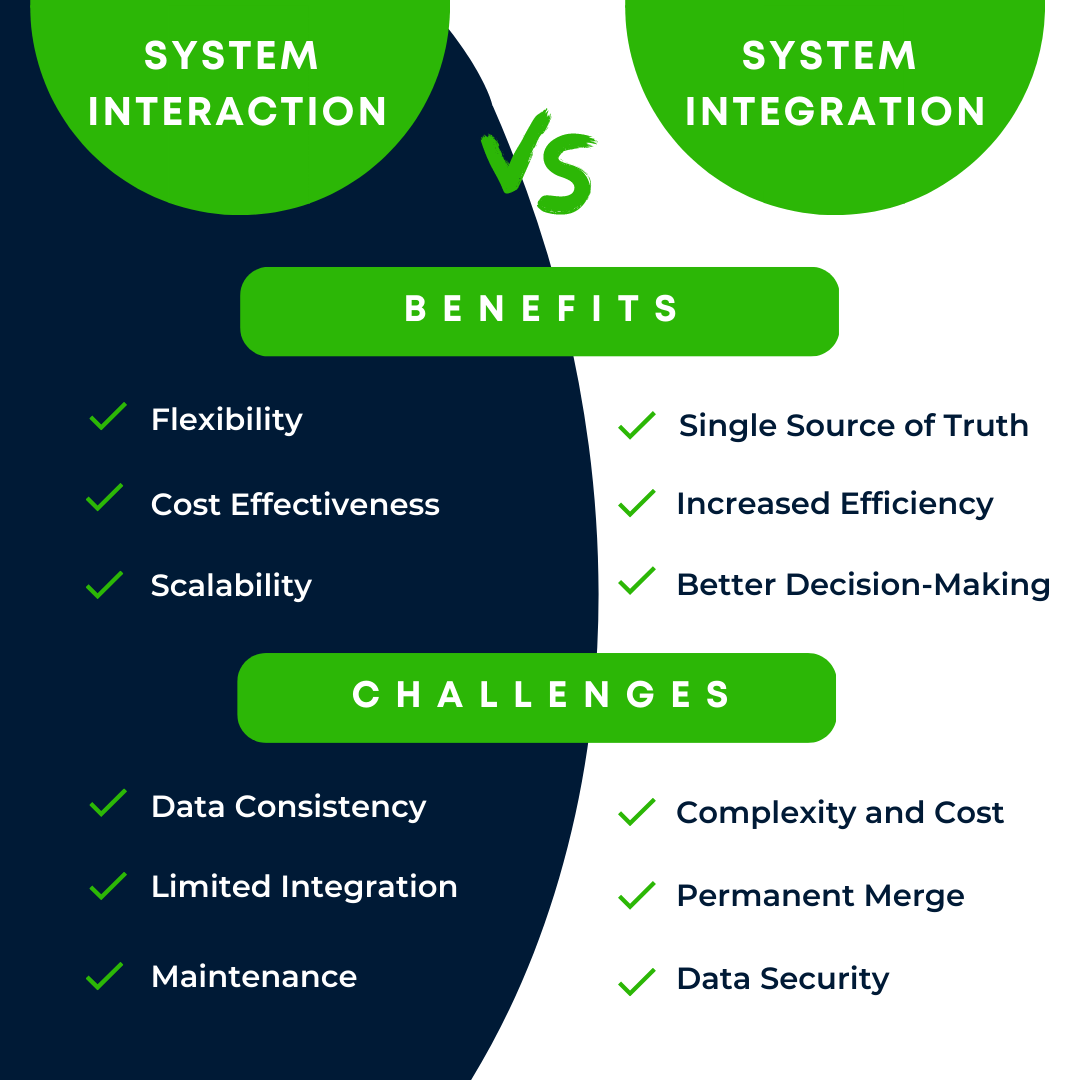Interaction vs. Integration: Which is Better?
When a company goes through an M&A (Merge & Acquisition), two or more systems need to either “integrate” or “interact.” What do these two words mean, and how are they different?
It is common to find the two words used interchangeably, but for this blog, we will define things as below:
Interaction connects and integration combines.
- Interaction allows the systems to work as one while remaining separate.
- Integration makes the systems into one.
Let’s dig a little deeper into the meaning and functionality of these two approaches.

What is the difference between system interaction and integration?
System interaction refers to the way different systems interact with each other. This can include how different systems share data, communicate with each other, and work together to achieve a common goal. System interaction is typically focused on the exchange of information between systems rather than on integrating systems.
On the other hand, system integration refers to the process of combining different systems into a cohesive whole. This can include integrating different data, software, and hardware systems. System integration aims to create a seamless experience for the user, where all systems work together efficiently to share data.
When to use “interaction” vs. “integration?”
The choice between system interaction and system integration depends on the specific business scenario and the organization's goals.
System interaction may be the better approach in scenarios where different systems need to share information but do not need to be tightly integrated. For example, suppose a company needs to share customer data between its CRM and marketing automation systems. In that case, system interaction can facilitate the exchange of information between these two systems without the need for full integration.
On the other hand, in scenarios where different systems need to come together into a single data store, system integration may be the better approach. For example, if a company is implementing an enterprise resource planning (ERP) system to manage its financial, manufacturing, and supply chain operations, system integration would be necessary to ensure that all these systems work based on a single data set in real time.
Both approaches may be required to achieve the best results in some cases. For example, a company may use system interaction to share information between its CRM and marketing automation systems and then use system integration to integrate the CRM and marketing automation systems with the company's ERP system to provide a seamless user experience across all systems.
The Benefits
System Interaction:
- Flexibility: System interaction allows different systems to share information without full integration, providing greater flexibility for organizations to use other systems as needed.
- Cost-effective: System interaction can be more cost-effective than full integration, as it typically requires less time and resources to implement.
- Scalability: System interaction can be easily scaled to include new systems as needed without extensive integration work.
System Integration:
- Single source of truth: System integration allows different systems to work based on one system, which can minimize errors related to running multiple systems.
- Increased efficiency: System integration can automate processes and improve the flow of information between different systems, leading to increased efficiency and productivity.
- Better decision-making: System integration can provide better visibility into data and insights, supporting better decision-making and strategic planning.

The Challenges
System Interaction:
- Data consistency: If different systems are not correctly configured to share information, it can lead to inconsistencies in the data and make it difficult to gain accurate insights.
- Limited integration: System interaction does not provide the same level of integration as full integration, which can lead to data sharing and process automation limitations.
- Maintenance: Maintaining the different interfaces between systems can be time-consuming and lead to increased complexity.
System Integration:
- Complexity and cost: Integrating different systems can be complex and time-consuming, leading to increased costs and delays.
- Permanent merge: System integration needs to be carefully thought through as it takes more effort to split the system.
- Data security: Integrating different systems can also increase the risk of data breaches and security threats if proper security measures are not implemented during the merge.
Best Practice: A phased approach moving from interaction to integration
A phased approach to moving from system interaction to system integration can be a helpful strategy for organizations looking to improve how their systems work together. This approach involves breaking the integration process into smaller, manageable phases, allowing organizations to implement changes incrementally rather than all at once.
The first phase of this approach would involve identifying the systems that need to interact with each other and establishing basic interfaces between them. This typically involves using APIs or other methods of data exchange to allow the systems to share information. This phase would focus on system interaction, allowing the different systems to share information but not necessarily work together cohesively.
The second phase would involve expanding on the basic interfaces established in the first phase to add additional functionality and improve the flow of information between the systems. This phase would enhance system interaction creating a more seamless user experience.
The final phase would involve fully integrating the systems as a cohesive whole. This phase would include integrating different software, hardware, and data systems to create a seamless experience for the user. This phase would focus on system integration, creating a cohesive whole by combining different systems.
Organizations can minimize the risks and costs associated with integration by using a phased approach to moving from system interaction to system integration while still achieving their goals.
This approach allows organizations to test the integration and make necessary adjustments before the final phase of integration. It also will enable organizations to prioritize their integration efforts and focus on the most critical systems first.
More to Learn…
Learn more about what an Interactor is and why we called our organization Interactor. Anything we can help with? Reach out to schedule a call.
Tags:
API Integration
March 15, 2023

Comments